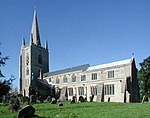Wiggenhall St Germans SSSI
Geological Conservation Review sitesSites of Special Scientific Interest in Norfolk

Wiggenhall St Germans SSSI is a 5.2-hectare (13-acre) geological Site of Special Scientific Interest south of King's Lynn in Norfolk. It is a Geological Conservation Review site.This site provides evidence for sea level changes during the Quaternary period, the last 2.6 million years. There are three peat layers, interspersed with fine-grained clastic rocks, and they have been studied with pollen and foraminifera analyses.A public footpath crosses the site.
Excerpt from the Wikipedia article Wiggenhall St Germans SSSI (License: CC BY-SA 3.0, Authors, Images).Wiggenhall St Germans SSSI
Sluice Road, King's Lynn and West Norfolk Wiggenhall St. Germans
Geographical coordinates (GPS) Address Nearby Places Show on map
Geographical coordinates (GPS)
| Latitude | Longitude |
|---|---|
| N 52.699 ° | E 0.349 ° |
Address
Sluice Road
Sluice Road
PE34 3ET King's Lynn and West Norfolk, Wiggenhall St. Germans
England, United Kingdom
Open on Google Maps









